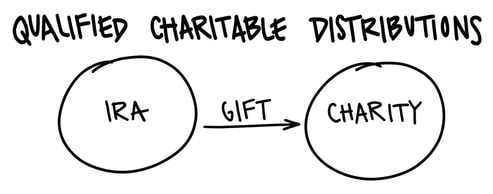|
Do you want to shave your tax bill, while also benefiting your favorite charity? I know I get excited anytime I can knock out two or more items with a single punch (i.e. the old kill two birds with one stone analogy). I am sure many of you are like me. In fact, this weekend is a great example as we celebrated Father’s Day for my father-in-law and combined that with my daughter’s 22nd birthday. How much more bang for the buck can you get unless maybe you were also celebrating everyone in the family’s birthdays the same weekend! I am sure my wife will not let me get away with that one! Today, I am going to give you three strategies that can help you kill two birds with one stone. They are two-fers (i.e. two for one ideas)! Donate Appreciated Stock Let’s face facts, after a ten-year economic cycle, we all should have some stocks, mutual funds or ETFs that now have low cost basis. This is the perfect time to give these appreciated marketable securities to charity instead of your hard-earned cash in the form of after-tax dollars. It seems so simple, but very few people consider it. As an example, we run a strategy called IA Equity Value whereby we buy and hold the ten highest dividend paying stocks in the Dow Jones Industrial Average, plus three additional positions that are either long or short at any point in time. (You can reach out to me if you want additional information on this strategy). The ten highest yielding stocks in the Dow Jones Industrial Average are rebalanced annually and do not change much from year-to-year. They tend to have some pretty large built-in gains when they do change. The strategy then is to donate that stock or stocks that will change in the annual rebalance, and then use the cash you would have used for charitable donations to buy the replacement stock positions. The result is a full charitable deduction for the donations (subject to certain limitations), the removal of a possible source of future capital gains from portfolio and the ability to rebalance without tax consequences. Pretty neat huh? Most charities will accept donations of marketable securities or you can use a donor advised fund to transfer the stock and then make your donations at a later time. Either way it works well. Qualified Charitable Distributions This second idea is only available to those taxpayers over age 70 and with large Individual Retirement Account (IRA) holdings. Although, I don’t know why Congress does not lower the age limit on this idea?
A Qualified Charitable Distribution is the ability of a taxpayer to give to charity directly from their IRA up to $100,000 per annum. This gift allows the taxpayer to avoid the ordinary income tax on the distribution and still support their favorite charity. The taxpayer does not receive a charitable deduction, but with the new higher standard deductions under the Tax Cuts and Jobs Act of 2017, this may not be a big deal. For more on this strategy see our past post entitled “Help Your Favorite Charity And Save Tax Dollars.” Gift Sequencing Our final two-fer is gift sequencing. What is gift sequencing? It is timing charitable gifts as to most benefit you and your income tax situation. Here is a simple example, let suppose you have been giving $10,000 annually to your favorite church, synagogue or temple. Unfortunately, these charitable expenses, your mortgage interest and property taxes add up to just $23,999, when the new standard deduction of $24,000 for married filing joint clients. This essentially gives you no incremental tax benefit for these cash outlays since you are $1 shy of the standard deduction amount. In our example, let suppose it is also nearing year-end and you closed on the sale of a property or received a large bonus. Lucky you! The solution is gift sequencing. In this example, why not make next year’s $10,000 charitable gift in the current year to essentially double up your charitable deductions in the current year. In most cases, you will not make a charitable contribution next year and will double up again the year after. This does two things, it puts you over the standard deduction and allows you to deduct $9,999 of charitable contributions that would likely not be deductible next year given similar inputs. It puts real money back in your pocket. Secondly, if you use a donor advised fund like Fidelity Charitable Gift or Vanguard Charitable Fund, you can still decide when to ultimately put that money in the hands of the charity based on when and how you make grant recommendations. Obviously, you need to be supporting a real 501(c)3 charity or you risk your grant recommendation being denied, but for most of you that should not be a problem. There you have it, how to get more bang for your charitable buck while potentially reducing your income tax bill. Let me know your thoughts or ideas. Disclaimer: This material has been prepared for informational purposes only, and is not intended to provide, and should not be relied on for, tax, legal or accounting advice. You should consult your own tax, legal and accounting advisers before engaging in any transaction.
0 Comments
Your comment will be posted after it is approved.
Leave a Reply. |



